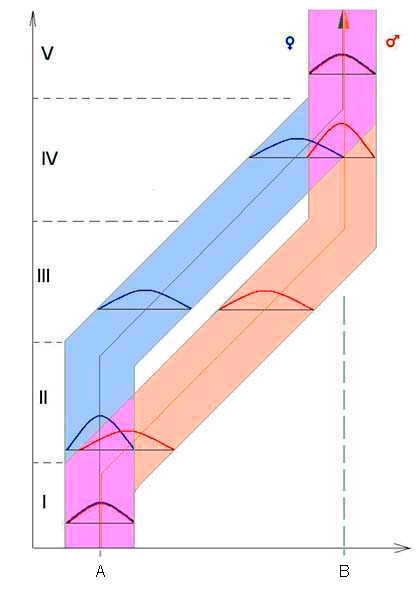|
The Evolutionary Theory of
Sex:
Dimorphism and Dichronism in Phylogeny
 On
the phylogenetic time scale when stable environment starts
changing, the new trait appears only in males and the
evolution begins (Figure).
This is initial,
divergent phase
(II). Evolution trajectory divides into male and female
branches. The genotypic sexual dimorphism appears and
improves in a series of generations. The duration of the
divergent phase or sexual dichrony (SDC) equals the
lagging time of the female sex or leading time of the male
sex (Figure).
This temporal “distance” is necessary to test the new traits
in the male subsystem. On
the phylogenetic time scale when stable environment starts
changing, the new trait appears only in males and the
evolution begins (Figure).
This is initial,
divergent phase
(II). Evolution trajectory divides into male and female
branches. The genotypic sexual dimorphism appears and
improves in a series of generations. The duration of the
divergent phase or sexual dichrony (SDC) equals the
lagging time of the female sex or leading time of the male
sex (Figure).
This temporal “distance” is necessary to test the new traits
in the male subsystem.
However, the divergence of sexes cannot continue
indefinitely, otherwise it would result in reproductive
isolation. A mechanism of
genotypic sexual dimorphism
relaxation is turned on; the information starts flowing from
males to the females and the evolution of females begin.
This is the parallel
stage (III), when the trait evolves in both sexes at the
same rate. The genotypic sexual dimorphism remains the same.
The third, convergent stage of evolution (IV) begins when
males are no longer affected by the ecological differential,
whereas females are still under the effect of genotypic
sexual dimorphing. The genotypic sexual dimorphism decreases
and then vanishes, the dimorphic trait becomes monomorphic
(stable), and the evolution of the trait ends.

Figure
Ordinate: Stages of the trait’s
evolution.
Abscissa: A and B — initial and
new value of the trait.
The evolution of any character passes
through the sexual dimorphism stage, therefore
sexual dimorphism is a consequence of any type of
selection: natural, sexual or artificial.
Sexual dimorphism on any trait exists only during its
evolution. It appears when evolution starts, exists when it
goes and disappears with its end. The absence of sexual
dimorphism means that the trait is stable. So, the presence
or absence of sexual dimorphism can serve as a criterion of
trait’s evolution. If we consider vector of sexual
dimorphism as a “compass” one can say that it’s an arrow
pointing from the female to male norm and so, the trait is
changing from female form towards the male one. This is
“Phylogenetic rule of sexual dimorphism”. Phase of the
evolution process can be determined based on dispersions
of the sexes. If the dispersion of a trait is larger
in males — the phase of its evolution is divergent;
if dispersions are equal – the phase is parallel; if
dispersion is higher in females — the phase is convergent.
This is “Phylogenetic
rule of dispersion”.
Continue to :
Sexual Dimorphism—Forms
More about Sexual Dimorphism:
Evolutionary Chromosomes And Evolutionary Sex Dimorphism.
Geodakyan V. A. Biology Bulletin, 2000, v. 27, № 2,
p. 99–113. Translated from Izvestija Akademii Nauk, Serija
Biologicheskaya, No. 2, pp. 133-148, 2000.
Evolutionary Logics of Sex Differentiation. Reaction Norm,
Sexual Dimorphism, "Paternal Effect".
Geodakian V. A.
|